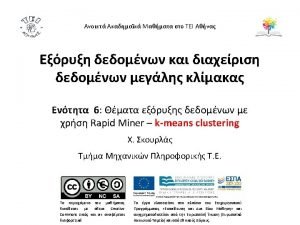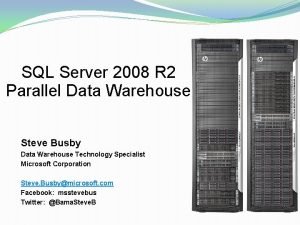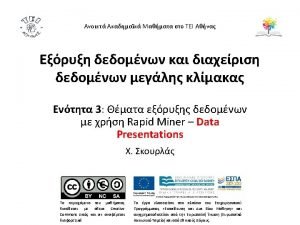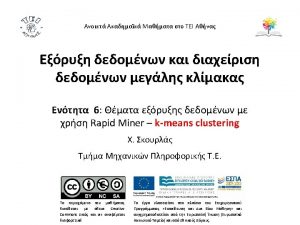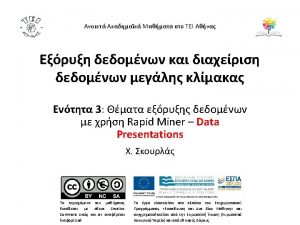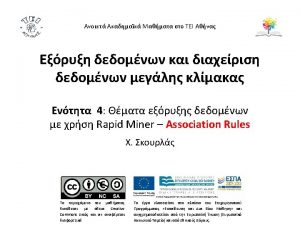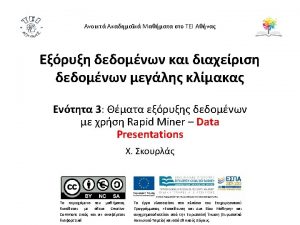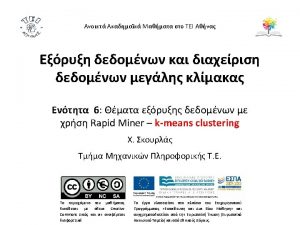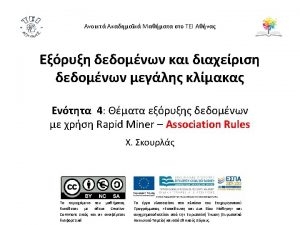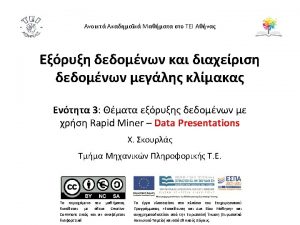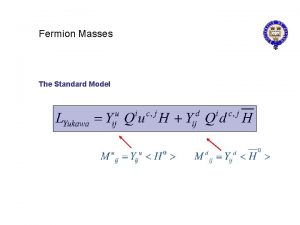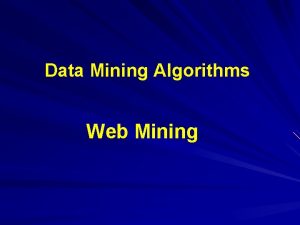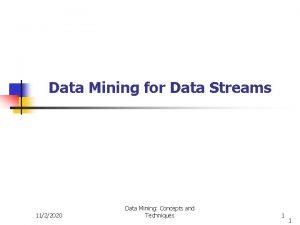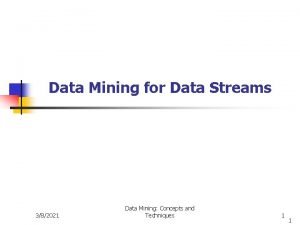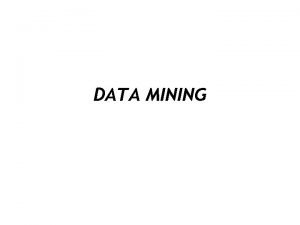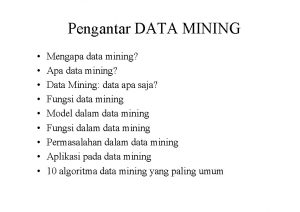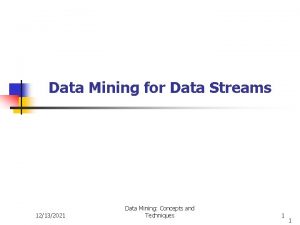M North Data Mining for the Masses 2012




































- Slides: 36



Ενδεικτική Βιβλιογραφία • M. North, Data Mining for the Masses, 2012, ISBN: 978 -0615684376 • This book is licensed under a Creative Commons Attribution 3. 0 License

CRISP-DM Conceptual Model Data Mining for the Masses 3

παράδειγμα: k-means cluster data mining model (χρήση Rapid. Miner) • Sonia’s goal is to identify and then try to reach out to individuals insured by her employer who are at high risk for coronary heart disease because of their weight and/or high cholesterol. She understands that those at low risk, that is, those with low weight and cholesterol, are unlikely to participate in the programs she will offer. She also understands that there are probably policy holders with high weight and low cholesterol, those with high weight and high cholesterol, and those with low weight and high cholesterol. She further recognizes there are likely to be a lot of people somewhere in between. In order to accomplish her goal, she needs to search among the thousands of policy holders to find groups of people with similar characteristics and craft programs and communications that will be relevant and appealing to people in these different groups. • (M. North, Data Mining for the Masses, 2012 Διασκευή παραδείγματος κεφαλαίου 6) 4

https: //sites. google. com/site/dataminingforthemasses/ Weight, Cholesterol, Gender 102, 111, 1 115, 135, 1 115, 136, 1 140, 167, 0 130, 158, 1 198, 227, 1 114, 131, 1 145, 176, 0 191, 223, 0 5


A new data mining project in Rapid. Miner The Rapid. Miner start screen 7

Import Data Set 8

Import Data Set 9

Names of the attributes 10

Where to store 11

Data View 12

Meta Data View 13

Toggle between Design Perspective and Results Perspective Design Perspective 14

Design Perspective 15

Play 16

modeling The ‘k’ in k-means clustering stands for some number of groups, or clusters. The aim of this data mining methodology is to look at each observation’s individual attribute values and compare them to the means, or in other words averages, of potential groups of other observations in order to find natural groups that are similar to one another. The k-means algorithm accomplishes this by sampling some set of observations in the data set, calculating the averages, or means, for each attribute for the observations in that sample, and then comparing the other attributes in the data set to that sample’s means. The system does this repetitively in order to ‘circle-in’ on the best matches and then to formulate groups of observations which become the clusters. As the means calculated become more and more similar, clusters are formed, and each observation whose attributes values are most like the means of a cluster 17 become members of that cluster.

K-means operators 18

model 19

Parameter pane: 2 clusters, max runs 10 20

Initial report 21

Parameter pane: 4 clusters, max runs 10 22

4 clusters 23

Centroid table (“cluster 0 is where Sonia will likely focus her early efforts”) 24

Folder view

cluster_0 26

details 27

Filter 28

Filter Examples 29

Parameters 30

Data view: Filtered results for cluster 0 observations 31




 Eck
Eck Mnorthdata
Mnorthdata Mnorthdata
Mnorthdata Mining multimedia databases in data mining
Mining multimedia databases in data mining Air masses in north america
Air masses in north america Types of air masses in north america
Types of air masses in north america North american air masses
North american air masses Strip mining vs open pit mining
Strip mining vs open pit mining Mineral resources and mining chapter 13
Mineral resources and mining chapter 13 Difference between strip mining and open pit mining
Difference between strip mining and open pit mining Web text mining
Web text mining Data reduction in data mining
Data reduction in data mining Data mining in data warehouse
Data mining in data warehouse What is missing data in data mining
What is missing data in data mining Data reduction in data mining
Data reduction in data mining Data reduction in data mining
Data reduction in data mining Data reduction in data mining
Data reduction in data mining Shell cube in data mining
Shell cube in data mining Data reduction in data mining
Data reduction in data mining Perbedaan data warehouse dan data mining
Perbedaan data warehouse dan data mining Data mining dan data warehouse
Data mining dan data warehouse Data mining dan data warehouse
Data mining dan data warehouse Multidimensional analysis and descriptive mining of complex
Multidimensional analysis and descriptive mining of complex Olap data mining
Olap data mining Noisy data in data mining
Noisy data in data mining Three tier architecture of data warehouse
Three tier architecture of data warehouse Data preparation for data mining
Data preparation for data mining Data compression in data mining
Data compression in data mining Introduction to data warehousing and data mining
Introduction to data warehousing and data mining Data warehouse dan data mining
Data warehouse dan data mining Complex data types in data mining
Complex data types in data mining True north vs magnetic north
True north vs magnetic north Integrated care system north east
Integrated care system north east Lesson 1 the industrial north
Lesson 1 the industrial north The north pole ____ a latitude of 90 degrees north
The north pole ____ a latitude of 90 degrees north Parallel data warehouse sql server 2012
Parallel data warehouse sql server 2012 Kontinuitetshantering i praktiken
Kontinuitetshantering i praktiken

